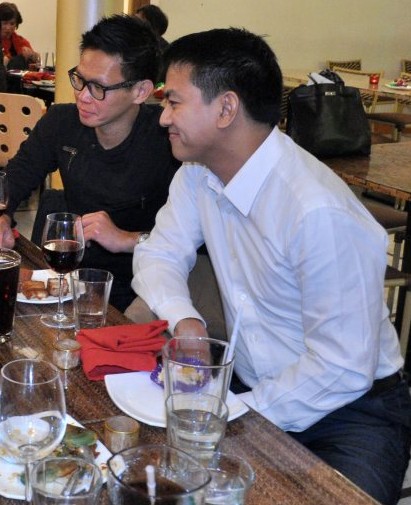KURI-KURI Lanao art from Anna Leah Sanson’s very productive hands
By Ricardo Jorge S. Caluen
It is perhaps providential that an art exhibit that showcases the exquisite artistic tradition of the Philippine South is currently on view in no other than New York City.
After all, a specific region– Lanao– has suffered its fair share of bad press owing to the fighting that has been ongoing in the area for months now between the Philippine military and the Maute-ISIS group.
From September 25 to October 6, visitors to the Philippine Center on Fifth Avenue, will be introduced to the art of Anna Leah Sanson, “Kuri-Kuri NYC.” The curated exhibit features some 30 art works divided into three sets, all highlighting not only the artist’s own proclivity to engage in kuri-kuri but also the industry that is required to create traditional craft– the subject of the paintings.
In Sebuano, kuri-kuri loosely describes the activity of very productive hands. The artist, Anna Leah, hails from Iligan City, once dubbed The Pittsburgh of the South because for a time it was the most industrialized city outside Manila. Smokestacks and silos do not form the backdrop of Anna Leah’s works, rather, it is the rich tapestry of the Higaunon-Meranaw culture pervasive in the area that serves as wellspring of her inspiration.
The intriguing okir (a general term used to describe the set of art motifs based on plant forms prevalent in the Lanao region and Sulu), intricate bead work, the mosaic weave of the banig, the burst of colors– they all jump from Anna Leah’s oeuvres rendered in oil and pastel.
One painting nuances a pining for the seemingly elusive peace in the region while another displays her feminist slant. In the banig series, Anna Leah hopes to educate the viewer that traditional art forms are mainly communal effort, as opposed to the more individualistic European artistic traditions. In the past, practically everyone in the village had a role to play in the process, be it the gathering and the drying of the natural supplies to the actual weaving, storing, and selling of the finished products.
Anna Leah never dreamt that one day she would share the limelight with respected names in the Philippine art scene who had earlier held exhibits at the Philippine Center, reputedly the place where Imelda Marcos had once held court.
Friends never expected Anna Leah to leave home to work as a caregiver in the USA. After all, she owns two very successful business enterprises in Iligan — MarRo’s Cocina, a popular bistro; and a flower shop popular among local wedding planners. But she followed her emotional compass, heading for New York perhaps feeling a tad of existential dread.
New York City is home to a good number of Iliganons and Anna Leah never wanted for good company. But, pretty soon, like most first-time expatriates, she felt lonely and homesick. Not to mention a few life’s questions needed closure. She found solace in creative activity. She picked up the brush and started to paint — furiously. Anna Leah painted so many canvasses and soon these attracted the attention of her employer who practically cajoled her into doing something purposeful with her paintings.
Anna Leah didn’t have to look far for inspiration for her paintings. She soaked up the vibrant colors and intricate designs of the native culture in Iligan. She had no formal schooling in art theories and techniques. She is raw talent. It helped that she grew up in a creative environment, helping her mother—a kindergarten teacher—prepare visual aids.
Orphaned of a father at age 13, Anna Leah had to help her family eke a living at such a tender age, designing wallets and selling them to classmates. If ever she learned a few art techniques, Anna Leah accomplished this by helping an Uncle — Adolfo “Ngangay” Lacuna, a master of the art of papier-mâché — create the masks and headdresses of the characters of Iligan’s famed San Miguel commedia, one of the few of this dying genre in the Philippines.
Anna Leah’s major artistic break came when she was asked to design and create the costumes and props of the internationally- renowned theatre group IPAG (Integrated Performing Arts Group). Soon Anna Leah became the most sought-after designer of costumes, stage, and props for street dancing festivals and other artistic productions in the area.
In New York City, Anna Leah made the acquaintance of some prominent names in American society, personalities who have either noticed her artistic pursuits or have come to learn about her advocacy.
One day, she received an invitation for a Fourth of July dinner at a penthouse of a condo close to the United Nations Headquarters. She found herself dining with the billionaire Samuel Irving “SI” Newhouse and wife Victoria, owners of Condé Nast, the publisher of Vogue, Vanity Fair, The New Yorker, etc. By accident, Mrs. Newhouse came across a brochure of Anna Leah’s first art exhibit where her dream of establishing a youth camp was mentioned. Famous for her many charities, Mrs. Newhouse was curious about Anna Leah and her plans.
“I really wish my paintings would sell,” she said to this writer. “Then I will have seed money for the youth camp I had always dreamt of establishing for the needy youth in Iligan. There, they will not only learn livelihood skills but also develop character and learn to be self-sufficient.”
“Naka patiwas na ko sa ilang tanan,” she proudly said in Sebuano.
Anna Leah followed her heart. Hopefully, her dreams will come true.
Ricardo Jorge S. Caluen is a freelance writer based in Toronto. Educated in De la Salle University, UP, and the University of Toronto, he is former Chairman of the Department of Political Science at the Mindanao State University-Iligan Institute of Technology. He was editor for many years of The Filipino Bulletin, a Toronto-based publication.
© 2017 The FilAm
















